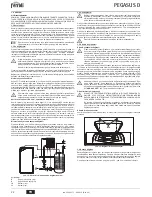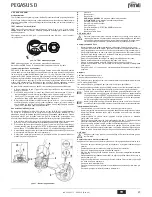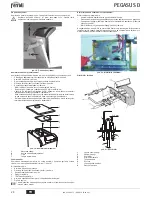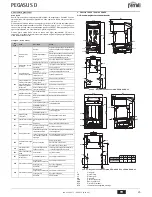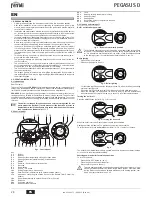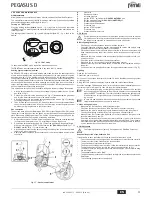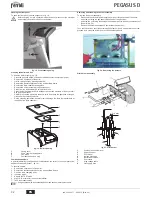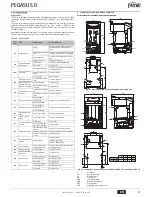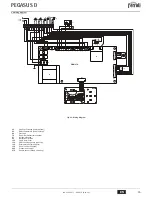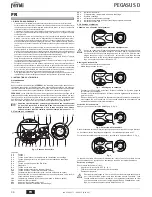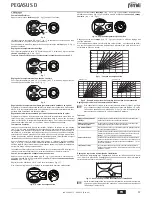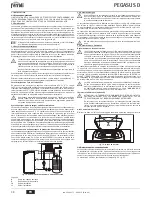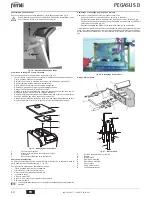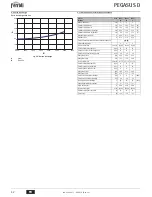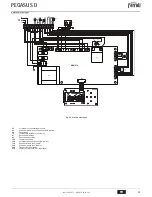
PEGASUS D
30
EN
cod. 3540U171 - 06/2012 (Rev. 00)
3. 2. INSTALLATION8
3.1 General Instructions
BOILER INSTALLATION MUST ONLY BE PERFORMED BY QUALIFIED PERSON-
NEL, IN ACCORDANCE WITH ALL THE INSTRUCTIONS GIVEN IN THIS TECHNICAL
MANUAL, THE PROVISIONS OF CURRENT LAW, THE PRESCRIPTIONS OF NA-
TIONAL AND LOCAL STANDARDS AND THE RULES OF PROPER WORKMANSHIP.
3.2 Place of installation
The boiler unit must be installed in a specific room with ventilation openings to the out-
side as prescribed by current regulations. If there are several burners or suction units
that can work together in the same room, the ventilation openings must be sized for si-
multaneous operation of all the units. The place of installation must be free of flammable
materials or objects, corrosive gases, powders or volatile substances that, conveyed by
the burner fan, can obstruct the internal lines of the burner or the combustion head. The
room must be dry and not exposed to rain, snow or frost.
A
If the unit is enclosed in a cabinet or mounted alongside, a space must be pro-
vided for removing the casing and for normal maintenance operations.
3.3 Plumbing connections
The heating capacity of the unit must be previously established by calculating the build-
ing's heat requirement according to the current regulations. The system must be provid-
ed with all the components for correct and regular operation. It is advisable to install
shutoff valves between the boiler and heating system allowing the boiler to be isolated
from the system if necessary.
B
The safety valve outlet must be connected to a funnel or collection pipe to pre-
vent water spurting onto the floor in case of overpressure in the heating circuit.
Otherwise, if the discharge valve cuts in and floods the room, the boiler manu-
facturer cannot be held liable.
Do not use the water system pipes to earth electrical appliances.
Before installation, carefully wash all the pipes of the system to remove any residuals or
impurities that could affect proper operation of the unit.
Carry out the relevant connections according to the diagram in cap. 5.1 and the symbols
given on the unit.
Water system characteristics
In the presence of water harder than 25° Fr (1°F = 10ppm CaCO3), use suitably treated
water in order to avoid possible scaling in the boiler. Treatment must not reduce the hard-
ness to values below 15°F (Decree 236/88 for uses of water intended for human con-
sumption). Treatment of the water used is indispensable in case of very large systems
or with frequent introduction of replenishing water in the system.
B
If water softeners are installed at the boiler cold water inlet, make sure not to
reduce the water hardness too much, as this could cause early deterioration of
the magnesium anode in the hot water tank.
Antifreeze system, antifreeze fluids, additives and inhibitors
The boiler is equipped with an antifreeze system that turns on the boiler in heating mode
when the system delivery water temperature falls under 6°C. The device will not come
on if the electricity and/or gas supply to the unit are cut off. If it becomes necessary, it is
permissible to use antifreeze fluid, additives and inhibitors only if the manufacturer of
these fluids or additives guarantees they are suitable for this use and cause no damage
to the heat exchanger or other components and/or materials of the boiler unit and sys-
tem. It is prohibited to use generic antifreeze fluid, additives or inhibitors that are not ex-
pressly suited for use in heating systems and compatible with the materials of the boiler
unit and system.
Connection to a storage tank for domestic hot water production
The unit's electronic board is arranged for managing an external storage tank for domes-
tic hot water production. Carry out the plumbing connections according to the diagram
fig. 14 (pumps and non-return valves must be supplied separately). Carry out: electrical
connections as shown in the wiring diagram incap. 5.4. A probe FERROLImust be used.
At the next lighting, the boiler's control system recognises the presence of the hot water
tank probe and automatically configures the DHW function, activating the display and rel-
evant controls.
fig. 14 - Diagram of connection to external hot water tank
Key
8
Domestic hot water outlet
9
Cold water inlet
10
System delivery
11
System return
3.4 Gas connection
B
Before making the connection, make sure the unit is arranged for operation with
the type of fuel available and carefully clean all the system gas pipes to remove
any residuals or impurities that could affect proper operation of the boiler.
The gas must be connected to the respective union (see fig. 25) in conformity with cur-
rent regulations, with a rigid metal pipe or with a continuous surface flexible s/steel tube,
installing a gas cock between the system and boiler. Make sure all the gas connections
are tight.
The capacity of the gas meter must be sufficient for the simultaneous use of all the ap-
pliances connected to it. The diameter of the gas pipe leaving the boiler does not deter-
mine the diameter of the pipe between the unit and the meter; it must be chosen
according to its length and pressure losses, in conformity with the current regulations.
B
Do not use the gas pipes to earth electrical appliances.
3.5 Electrical connections
Connection to the electrical grid
B
The unit's electrical safety is only guaranteed when correctly connected to an
efficient earthing system executed according to current safety standards. Have
the efficiency and suitability of the earthing system checked by professionally
qualified personnel. The manufacturer is not responsible for any damage
caused by failure to earth the system. Also make sure that the electrical system
is adequate for the maximum power absorbed by the unit, as specified on the
boiler dataplate.
The boiler is prewired and provided with a Y-cable and plug for connection to the elec-
tricity line. The connections to the grid must be made with a permanent connection and
equipped with a bipolar switch whose contacts have a minimum opening of at least 3
mm, interposing fuses of max. 3A between the boiler and the line. It is important to re-
spect the polarities (LINE: brown wire / NEUTRAL: blue wire / EARTH: yellow-green
wire) in making connections to the electrical line. During installation or when changing
the power cable, the earth wire must be left 2 cm longer than the others.
B
The user must never change the unit's power cable. If the cable gets damaged,
switch off the unit and have it changed solely by professionally qualified person-
nel. If changing the electric power cable, use solely
“HAR H05 VV-F”
3x0.75
mm2 cable with a maximum outside diameter of 8 mm.
Room thermostat (optional)
B
IMPORTANT: THE ROOM THERMOSTAT MUST HAVE VOLTAGE-FREE
CONTACTS. CONNECTING 230 V TO THE ROOM THERMOSTAT TERMI-
NALS WILL PERMANENTLY DAMAGE THE ELECTRONIC BOARD.
When connecting time controls or a timer, do not take the power supply for
these devices from their breaking contacts Their power supply must be by
means of direct connection from the mains or with batteries, depending on the
kind of device.
Accessing the electrical terminal block
Undo the two screws
“A”
located on the top part of the control panel and remove the
cover.
fig. 15 - Accessing the terminal board
3.6 Connection to the flue
The flue connection pipe diameter must not be less than that of the connection on the
anti-backflow device. Starting from the anti-backflow device it must have a vertical sec-
tion at least 50 cm long. Comply with the current standards regarding installation and siz-
es of the flues and connection pipe.
The diameter of the anti-backflow device collar is given in fig. 22 - fig. 23.
8
9
10
11
A
Summary of Contents for PEGASUS D
Page 62: ......
Page 63: ......
Page 64: ...FERROLI S p A Via Ritonda 78 a 37047 San Bonifacio Verona ITALY www ferroli it...







